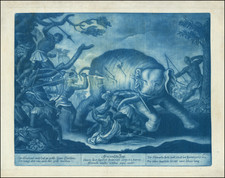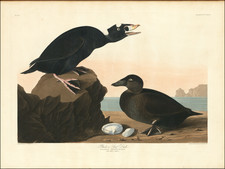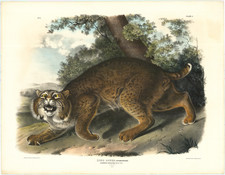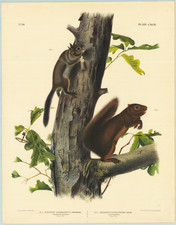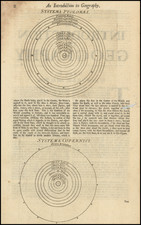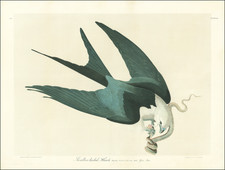A handsome example of the Julius Bien edition of John James Audubon's Pinnated Grous.
The chromolithograph captures a behavioral moment among the Pinnated Grouse, also known as Greater Prairie Chickens, a bird species native to the North American prairies. The two male birds are shown amid a competition, a common display to assert dominance and vie for the attention of a female. Their postures suggest a ritualistic display, a behavior typical of many grouse species during mating season. One male flies towards the other, feathers fluffed out, asserting his presence, while the other responds with a similar, if more defensive, gesture.
Contrastingly, the female bird, discernible by her subdued coloration and markings, appears more reserved, possibly even apprehensive. She keeps her head down, while observing the ongoing competition, perhaps feeling the weight of being the subject of such intense attention.
Set against the backdrop of a serene prairie landscape, the scene is enlivened by the detailed foreground of grasses and yellow lilies (perhaps Turk's-cap lilies). The distant water body surrounded by gentle hills anchors the setting and emphasizes the vastness of the habitat these birds occupy.
Birds of America: The Bien Edition
The legacy of John James Audubon's Birds of America is one of unbridled passion for ornithology and artistry, a blend of meticulous observation with artistic flair. While the original "Double Elephant Folio" edition is justifiably celebrated for its monumental contribution to ornithology and fine art printing, it is the lesser-known Bien Edition that stands as an equally impressive testament to the evolution of printing technology and the continued appreciation of Audubon’s work.
Julius Bien (1826-1909) was a German-born American lithographer and cartographer, renowned for his significant contributions to American cartography during the 19th century. Born on September 27, 1826, in Naumburg, Germany, Bien originally trained in his homeland, mastering the nascent craft of chromolithography, a method for producing multi-color prints.
In the 1850s, Bien emigrated to the United States, where he set up his own lithography firm, Julius Bien & Co., in New York. His innovative techniques and meticulous attention to detail quickly earned him a reputation as one of the country's leading lithographers. The firm became known for its wide range of work, from maps and atlases to commercial prints and illustrations.
One of Bien's most significant collaborations was with the U.S. government, particularly the U.S. Geological Survey (USGS). In the late 19th century, the USGS undertook the ambitious project of mapping the entire United States. Bien's firm was responsible for producing many of these topographical maps, and he introduced advanced printing techniques that enhanced their clarity, precision, and detail.
However, not all of Bien's ventures were successful. His attempt at reproducing a double elephant folio edition of Audubon's Birds of America in the 1860s, for instance, was left incomplete due to financial challenges posed by the Civil War. Despite this, many of the plates he did produce for this edition are considered masterpieces of chromolithography.
Julius Bien passed away on December 21, 1909, in New York. His contributions to lithography and cartography in the U.S. left a lasting legacy, with many of his techniques becoming standard practice in the field. His maps, in particular, serve as a testament to the evolving understanding and depiction of the American landscape during a period of rapid westward expansion and scientific exploration.
John James Audubon (1785-1851), born Jean-Jacques Rabin in Haiti on April 26, 1785, was a Franco-American ornithologist, naturalist, and painter, celebrated for his detailed illustrations of North American birds in their natural habitats. His major work, a color-plate book titled The Birds of America, is considered one of the finest ornithological works ever produced.
Audubon's early years were shaped by tumultuous events. Born out of wedlock in the French Caribbean colony of Saint-Domingue (now Haiti) to a Creole mother and a French sea captain, he was smuggled to Nantes, France, during a slave rebellion. There, he was adopted by his father and stepmother and raised as their own. His childhood in France was filled with outdoor adventures and initial forays into drawing.
In 1803, to avoid conscription into Napoleon's army, he was sent to America, where he managed one of his father's estates near Philadelphia. This move further kindled his profound interest in the wildlife of the New World. Despite a few failed business ventures and challenges, Audubon remained committed to his passion for nature and art.
His dream to document all of the birds of America began to take form in the 1810s. Travelling through America's wilderness, Audubon observed, hunted, and painted birds. He developed a particular technique that involved wiring freshly killed birds into a natural pose on a board. This innovative method combined with his keen observation allowed him to create more lifelike illustrations than many of his contemporaries.
Failing to secure American subscribers or a publisher for his extensive collection, Audubon traveled to the United Kingdom in 1826. There, The Birds of America was met with critical acclaim. Between 1827 and 1838, this work was published in sections, comprising 435 hand-colored, life-sized prints made from engraved plates.
Audubon followed this success with a companion work, Ornithological Biography, which provided detailed narratives about each species. His later work included studies of American mammals, and he became one of the founding members of the New-York Historical Society.
Despite facing numerous challenges throughout his life, including financial hardships and criticism from some peers, Audubon's dedication to his work resulted in an invaluable contribution to ornithology and American art. He died on January 27, 1851, in New York City. Today, his legacy continues, notably through the National Audubon Society, which promotes conservation and appreciation of birds and their habitats.











